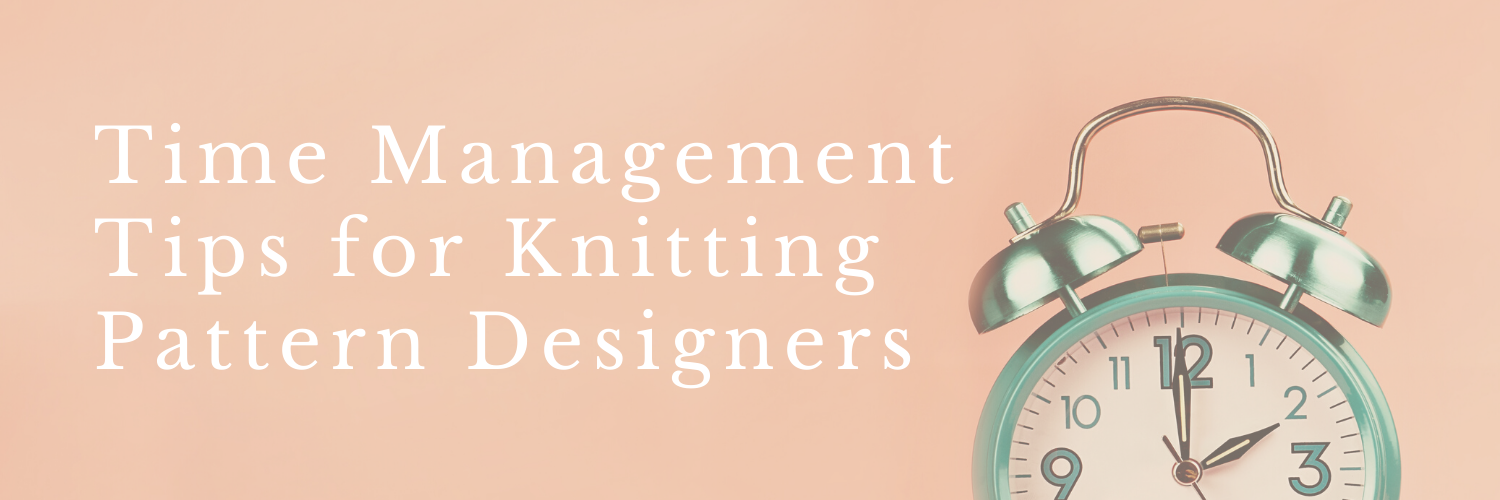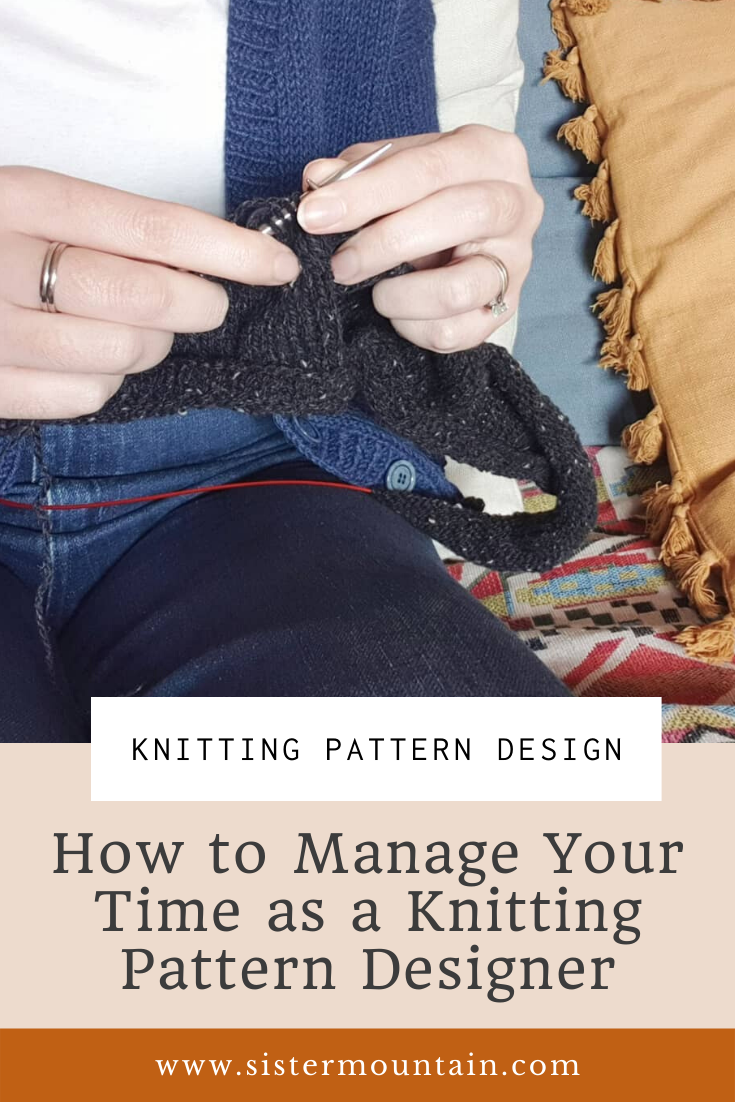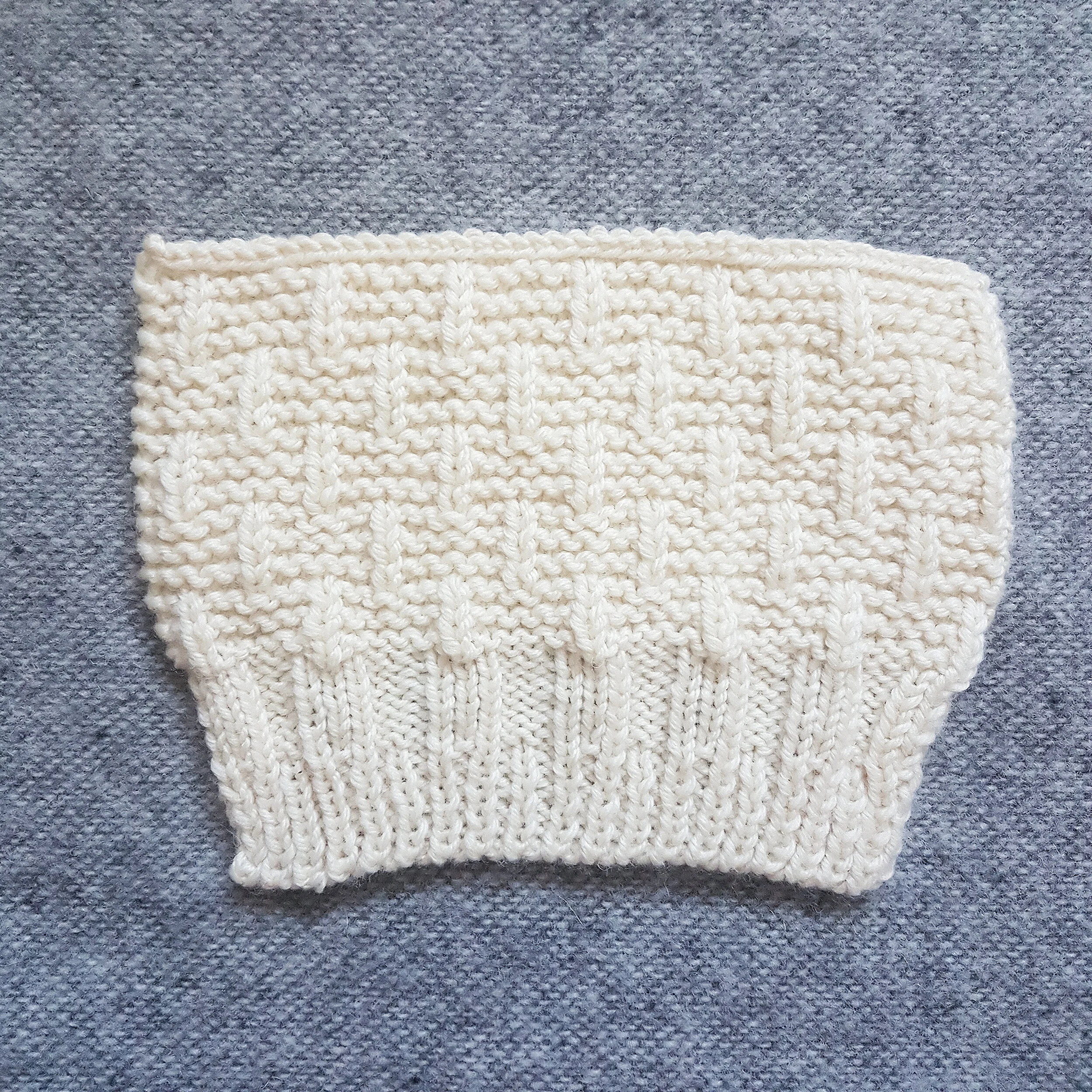How to Make the Time for Designing Knitting Patterns
Juggling knitting pattern design alongside all of your other responsibilities can be a big challenge.
Designing knitting patterns is a time-intensive pursuit. It can take months from the start of the design process through to finally hitting publish on Ravelry.
On top of that, most of you will have significant commitments outside of your design career, whether that’s working a full-time job, taking care of small kids or both! The reality is that you don’t have the time for much else. How can you fit it all in?!
One of the biggest frustrations that knitting pattern designers have, both beginners and those who are more experienced, is not having enough time to work on designing like they want to. More often than not, knitting pattern designers have lots of ideas but not enough time to execute them!
So, how can you use what little time you have effectively?
Learning how to manage your time as a knitting pattern designer is one of the most important skills you can learn. With a good system, you can make more time to design as well as manage the other responsibilities in your life. I’m not promising miracles here, but I will say that having a better handle on how you spend your time will certainly help.
Organise your digital or physical workspaces
If you can’t find what you need when you’re designing, it can really slow you down. I recommend that you set up a system to help you handle all of the files, graphics and photos that are involved in putting together a knitting pattern.
How you implement this system will differ according to whether you do most of your design work digitally or on paper.
This is how my desktop always looks - seeing folders and files on here stresses me out!
Digital Workspace Organisation
If you are a digital person, like me, you must set up a digital filing system for all of your pattern files. Don’t just throw them on your desktop - it will only stress you out! In fact, I’m a big believer in keeping an empty desktop!
Don’t believe me? Take a look at this screenshot.
I have a folder in my Google Drive called Designs which is where I store my pattern files. All of my patterns are split between Self-Published and Publications folders to help me find what I’m looking for quicker.
Within Publications, I have three more folders: Pending, Accepted and Rejected. This is how I keep track of my pattern submissions. I move them into their relevant folders as the submission process progresses. It’s always nice to go back to my rejected submissions and see if I want to self-publish them.
Within their respective folders, all of the pattern folders are in a folder called WIP and once I publish them, they are moved into Published. Within the Published folder, I also segment my patterns by category e.g. socks, sweaters etc. to make them easier to find.
Each individual pattern folder should have the same subfolders inside it, such as pattern drafts, final pattern, charts, photos, social media graphics etc. As soon as you start a new design project, set up the pattern folder with the empty subfolders inside so that they are ready to go whenever you have files to save.
Analogue Workspace Organisation
Of course, if you are more of an analogue person, this method might not be for you. Instead, you might want to set up a binder to keep all of your notes together. You could take the principles of the digital system I use and apply them to your paper system. The goal is to make sure that you know exactly where everything is and can find it very quickly.
Follow a Standardised Design Process
If you are often trying to figure out what the next step in your design process should be, it can really drag the whole thing out.
I recommend that you set up a standardised design process and track it in some kind of project management tool. I’ve talked about the system for my design process before, so I won’t go into much depth here about the specific steps in it here. If you want to learn more about the design process I follow, read How to Structure Your Knitting Pattern Design Process.
If you’re not tracking your design process through a project management tool already, I want to encourage you to do so. There are lots out there, such as Trello and my favourite: Asana. I use the free version and it offers me everything I need. A physical to-do list and a calendar will also do a fine job, but I like that I can access my to-do list from anywhere using just these digital tools.
When I start a new design project, I add all the tasks from my design process into Asana and if necessary, set dates.
If you are working to a specific deadline, I recommend working back from that date to set deadlines for each task in your design process. If you don’t have a deadline and you’re trying to fit your knitting pattern design into the small gaps of free time in an otherwise busy life, I don’t recommend setting strict deadlines anymore.
I used to believe in setting deadlines for all of my design projects, but after working myself into burnout due to my self-imposed deadlines, I have changed my mind.
My new goal is to work a set number of hours per week on my design projects (or more recently, this blog!) and as long as I work those hours, I’m happy for the projects to take as long as they take to get done.
It does take me longer to produce things, but at least I’m working in a sustainable manner that isn’t doing my health any long-term damage. If you are better at setting sustainable deadlines than I am, feel free to ignore this advice and set as many deadlines as you want!
Reconsider what types of patterns you want to focus on
Some types of knitting patterns take longer to produce than others, so that is definitely something to consider when planning your time.
I adore designing garments, but I’ll be the first to admit that they are not always the best choice when it comes to the time spent designing them and as a result, the profit margin.
If you have very limited time and want to have a higher output of patterns, focus on smaller accessories such as hats, socks and shawls that are quicker to knit and require less grading.
Work on one design at a time
It has been proven that multitasking is less effective than single-tasking and I believe that this applies to knitting pattern design.
It’s easy to get into a flow when you’re working on one design at a time. You remember where you are and can easily pick up where you left off because there are no long gaps between working on it. You will work more efficiently because you’re not having to deal with context switching all the time.
There will be points in your design process when you don’t need to be actively working on your design all the time, such as in the sample knitting or test knitting stages, so you could always start working on another project during that time, but go back to your original project as soon as you can.
That being said, it might actually be more efficient to start planning the marketing strategy for your knitting pattern release during those times. A successful release isn’t just about the design - your pattern promotion plays a big part in this. Use the lulls in your design process to invest time in planning a really great launch.
Think about your next design project ahead of time
Planning ahead is an easy way to save time in the long run. It keeps you moving, rather than wasting time trying to figure out what to work on next when you don’t have anything lined up.
Start thinking about your next design whilst you’re working on the current one. It gives you time to mull things over and weigh up your decisions before you need to make them. If you’re anything like me, this might come naturally to you. I can’t help but dream about several more projects whilst I’m working on another one!
Ideally, purchase yarn or arrange yarn support ahead of time so that you can get right to work when you’ve finished your current project.
Put it on the calendar
If it’s not on the calendar, it might not get done! That’s why I recommend scheduling your design work.
Every weekday morning, I wake up at 6am so that I can spend 1.5-2 hours on Sister Mountain before I start my freelance work. This works for me right now because I work from home and Ulysses and I don’t have children. If my lifestyle changes, I will certainly have to change my routine!
Try to find a regular time that you can spend on your design, whether it’s 20 minutes in the morning before anyone else gets up or 30 minutes on your lunch break at work (I used to do that when I worked in an office). Perhaps you could ask your partner to take the kids out once a week on a Sunday afternoon so that you can spend a couple of hours working quietly without being interrupted.
Stop wasting time on stuff that isn’t important to you
It’s all well and good scheduling time to work on your knitting pattern designs, but if you’re spending most of that scheduled time scrolling on social or refreshing your emails, that is time you can no longer use for design.
Why waste the little time you have set aside for design procrastinating when you could be making progress towards your goals?
If this is what you really want, focus the time you’ve set aside on knitting pattern design ONLY on knitting pattern design. Work your way through the steps in your design process checklist and don’t let yourself work on anything else until the time is up. How you spend the rest of your time is completely up to you!
Take short, regular breaks
If you have prolonged periods of time set aside for knitting pattern design, it can be hard to stay focused - especially if you’re working on a particularly challenging part of your design.
Something that I have used for years is called the “Pomodoro method”. Essentially, you work for 25 minutes, then take a 5 minute break. Repeat that one more time. Then work for 25 minutes and take a 30 min break. Then, you repeat everything all over again until you are done working.
I find that Pomodoro helps me to stay focused for longer whilst I’m working and then I can get up, take a break and have a drink or some food in the time in between. I always get more done this way than if I just forced myself to work continuously.
Consider outsourcing
I have only dabbled in this a little because, quite honestly, I couldn’t afford to do it very often! Whilst outsourcing can often result in more output and therefore, more income, it requires upfront investment and that is something I just don’t have at the moment! Maybe you do, which is why I’m sharing this.
The biggest thing that I sometimes outsource is sample knitting. I never used to because I love to knit. I also love to share photos of my design WIPs on social media and find it really hard to find sample knitters who are also able to take photos in my brand style.
Unfortunately, my body is not always cooperative and gets very sore when I spend too much time knitting. Additionally, I’m a pretty slow knitter. It takes me a while to knit a garment and whilst I don’t mind when it comes to personal projects, it can be a bit limiting when it comes to my design projects.
I started working with a wonderful woman called Nicky, who I met on Instagram. I was working on The Herbalist collection and needed to complete all three samples pretty quickly so I hired her to knit one of them. She is much faster than me and knits beautifully.
Working with Nicky meant that I didn’t have to spend all of my free time sample knitting and could choose to either work on other parts of the design process or enjoy much-needed downtime with my husband.
I also outsource all of the photography and photo editing because I know that my photographer, Joy from Simple Soulful Film, will do a much better job than me on this and in much less time.
There are other parts of the process that you could outsource that I haven’t yet tried, such as grading and pattern layout. Of course, this all depends on how much money you have coming in. If you are not making much money from your pattern sales, I wouldn’t focus on outsourcing until further down the line.
Ultimately, Do what works for you
Some of these tips will work for you; others won’t. That’s okay - commit to even just one of them and see how it affects your time management. If it helps, stick with it!
I’m not going to lie to you and tell you that becoming a prolific knitting pattern designer is an easy path. It isn’t! I haven’t managed it yet.
But I have become content with producing what I can in the time that I have available. Who knows - I might have more time in the future to produce more knitting patterns? But in the meantime, I am happy with my modest output.
I hope that you can find peace with whatever capacity you have too. Sure, find ways to optimise your time management but also, don’t try to rush the process so much that you lose your enjoyment of it. Do what you can with what you have. Most of the time, there’s really no rush.
Discussion
Which time management tactic are you going to try first? Share in the comments section so that I and the rest of The Sisterhood can cheer you on.





